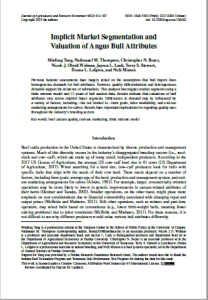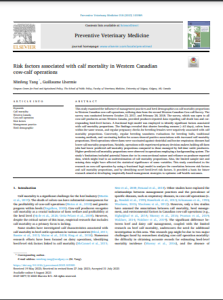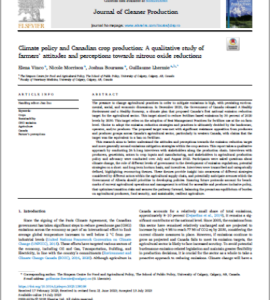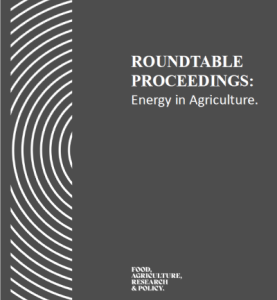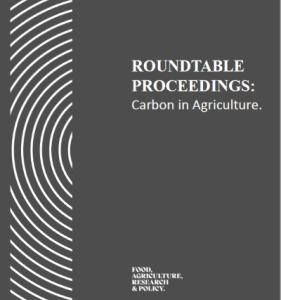Publications
Beef cattle production in the United States is characterized by diverse production and management systems. Much of this diversity occurs in the industry’s disaggregated breeding sectors (i.e., seedstock and cow–calf), which are made up of many small, independent producers. The effects of market segmentation on prices in hedonic models have long been discussed in the real estate literature. Despite knowledge of differences in derived demands for bull attributes among bull buyers and models equipped to handle these differences, to date there have been few attempts to identify and estimate attribute valuations across bull buyer segments. More work is needed to identify and understand bull buyer submarkets to improve the accuracy of marginal valuations of bull attributes.
The objective of this study is to identify heterogeneity in bull buyer valuations of bull attributes across latent classes using an FMM. This has important implications for seed-stock producers (i.e., those selling bulls), cow–calf producers (i.e., those buying bulls), and the industry as a whole as they seek to improve the quality and consistency of beef cattle and products. In this study, an FMM approach is applied to identify implicit bull buyer submarkets and examine bull buyers’ heterogeneous derived demands for bull attributes. Results indicate evidence of heterogeneous demands for bull attributes among bull buyers. A three-class FMM is identified as providing the best view of bull buyer heterogeneity. Differences in attribute valuations across latent classes of bull buyers appear to be associated with various aspects of producers’ production and management systems, including, but not limited to, farm goals, labor availability, and end-use marketing arrangements for calves.
Monday, October 30, 2023
Tang, M., Thompson, N.M., Boyer, C.N., Widmar, N.J.O. and Lusk, J.L.
Rangelands provide many ecosystem services such as food production, income for rural families and communities, recreation, wildlife habitat, soil carbon sequestration, plant and animal biodiversity, and water filtration. It is often assumed that grazing negatively impacts the natural ecosystem and that the removal of grazing would result in more pristine rangelands. Management-intensive grazing practices allow forages to store reserves during times of abundant precipitation, increase water-holding capacity, provide wildlife habitat at critical times of rearing young, and create a shifting mosaic with both old- and new-growth vegetation all the while maintaining animal productivity and income for ranchers. An analysis of the interaction between rangeland management practices and the ecosystem is needed.
The objective of this study was to determine the impact of combinations of management practices on the sustainability of rangelands in different ecoregions across the Great Plains. Six study sites were selected in Kansas, Nebraska, Wyoming, Montana, and South Dakota, encompassing the Flint Hills, High Plains, and Sandhills ecoregions. Twelve rangeland management scenarios were developed from combinations of stocking density (light, moderate, heavy), grazing management (continuous, rotational), and fire regime (no burn, spring burn) along with a no-management scenario. Each scenario was simulated at each site using established computer models: Agricultural Policy/Environmental eXtender model, Integrated Farm System Model, and Impact Analysis for Planning. Additionally, human-edible nutrient conversion was computed. A sustainability index was developed to encompass the three sustainability pillars (i.e., environmental, economic, and social) into a single value. Unmanaged rangelands generally had less soil (20%), nitrogen (30%), and phosphorus (50%) losses, although this was not consistent across ecoregions, and similar or greater soil carbon deposition than grazed rangelands. There was an interaction among stocking density, grazing management, fire regime, and ecoregion for many indicators of soil health, greenhouse gas emissions, economic activity, and human-edible nutrient conversion. The scenarios with the greatest overall sustainability index value had moderate to high index values for each of the three pillars (people, planet, profit). In conclusion, the ranking of rangeland management practices based on sustainability indicators was inconsistent across ecoregions, indicating that the optimal management system to improve sustainability of rangelands is not the same for all ecoregions.
Monday, October 30, 2023
Merri E. Day, Minfeng Tang, Phillip A. Lancaster, Deann Presley, Dustin L. Pendell, Walter H. Fick, Luca Doro, Adam Ahlers and Andrew Ricketts
Calf mortality is a significant concern for cow-calf producers, until recently, assessing the link between herd-level factors and calf mortality proportions has been challenging due to difficulties in securing reliable data. Our study addresses this issue by utilizing producer-reported causes of calf mortality and corresponding death loss data from a survey conducted in Western Canada.
This study examined the influence of management practices and herd demographics on calf mortality proportions in Western Canadian cow-calf operations, utilizing data from the second Western Canadian Cow-calf Survey. The survey was conducted between October 23, 2017, and February 28, 2018. The survey, which was open to all cow-calf producers across Western Canada, provided producer-reported data regarding calf death loss and corresponding herd-level factors. A fractional logit model was employed to identify significant factors associated with calf mortality proportions. The findings revealed that shorter breeding seasons (<63 days), calves born within the same season, and regular pregnancy checks for breeding females were negatively associated with calf mortality proportions. Conversely, regular breeding soundness evaluations for breeding bulls, traditional weaning methods, and vaccinating heifers for scours showed positive associations with increased calf mortality proportions. Herd operations where dams were vaccinated against clostridial and bovine respiratory diseases had lower calf mortality proportions. Notably, operations with experienced primary decision-makers holding off-farm jobs had lower predicted calf mortality proportions compared to those managed by full-time cattle producers. Higher predicted calf mortality proportions were observed in operations employing a backgrounding system. This study contributed to the research on cow-calf operation by using a fractional logit model to analyze the correlation between risk factors and calf mortality proportions, and by identifying novel herd-level risk factors. It provided a basis for future research aimed at developing empirically-based management strategies to optimize calf health outcomes.
Monday, October 30, 2023
Minfeng Tang and Guillaume Lhermie
The pressure to change agricultural practices in order to mitigate emissions is high, with persisting environmental, social, and economic dimensions. In December 2020, the Government of Canada released A Healthy Environment and a Healthy Economy, a climate plan that proposed Canada’s first national emission reduction target for the agricultural sector. This target aimed to reduce fertilizer-based emissions by 30 percent of 2020 levels by 2030. This target relies on the adoption of Best Management Practices for fertilizer use at the on-farm level. Choice to adopt the emission reduction strategies and practices is ultimately decided by the landowner, operator, and/or producer. The proposed target was met with significant resistance opposition from producers and producer groups across Canada’s agricultural sector, particularly in western Canada, with claims that the target was the equivalent to a ban on fertilizer.
This research aims to better understand the attitudes and perceptions towards the emission reduction target and more generally around emissions mitigation strategies within the crop sectors. This report takes a qualitative approach by conducting 26 h-long interviews with stakeholders along the production chain. Interviews with producers, geneticists, actors in crop inputs and manufacturing, and stakeholders in agricultural production policy and advocacy were conducted over July and August 2022. Participants were asked questions about climate change, the role of different levels of government in the development of emission regulations, potential strategies on a short- and long-term horizon basis, and incentives. Interviews were transcribed and categorically defined, highlighting reoccurring themes. These themes provide insight into awareness of different strategies considered by different actors within the agricultural supply chain, and potentially anticipate avenues which the Government of Alberta should prioritize in developing policies. Ensuring future protocols account for benchmarks of current agricultural operations and management is critical for accessible and producer-inclusive policy, that optimizes transition risks and secures the pathway forward, balancing the precarious equilibrium of burden on agricultural producers, food security, and sustainable, resilient agriculture.
Thursday, August 03, 2023
Elena Vinco, Nicole Morrison, Joshua Bourassa, Guillaume Lhermie.
Alberta’s economy has been based historically on its abundant natural resources, particularly energy and agriculture. The agriculture and energy sectors in Canada are deeply interconnected, since energy is a key input in agricultural production and agriculture provides feedstocks for bioenergy and biofuels. As the world transitions towards a low-carbon economy, both sectors face challenges and opportunities for decarbonization, sustainability and innovation. The Simpson Centre for Food and Agricultural Policy hosted a roundtable event that aimed to promote cross-sectoral collaboration and problem-solving for energy optimization in the agricultural sector. The event showcased the latest research and initiatives for energy production and consumption on Canadian farms and explored optimized energy solutions through collaborations between energy and agriculture. The discussions centered around co-production of agriculture and energy, and featured entrepreneurs, researchers and representatives from government and industry. The ultimate goal was to provide farmers with accessible, relevant, and trustworthy information to support them in their journey towards diversification of their farm operations.
Friday, July 14, 2023
Hanan Ishaque, Amlika Nair
Canada is a major global food exporter, but the projected increase of 1.7 billion in the world’s population by 2050, accompanied by a corresponding increase in food demand, poses a challenge to the country. Its federal policy targets a 30 percent reduction in Nitrous Oxide (N2O) emissions from 2020 levels by 2030, with the ultimate goal of achieving net zero emissions by 2050. Achieving these goals will impact the cost and competitiveness of Canadian agri-food products in the global market. This raises the question of whether feeding Canadians and the growing world population is more important than meeting emission reduction targets, or if both objectives can be achieved simultaneously.
Friday, July 14, 2023
Hanan Ishaque

